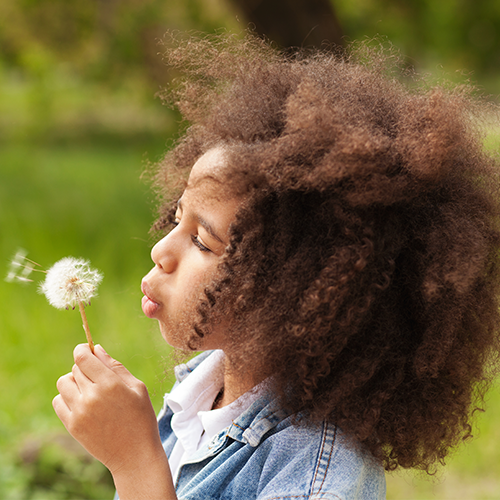As we cope with COVID-19, getting outside is something we are able, and encouraged, to do for fresh air and sunshine. Many families are soaking up the last bit of warm weather before fall. But for many children, this time of year also signals the beginning of a common health issue – allergies.
Dr. Gigi Chawla, chief of general pediatrics at Children’s Minnesota, talked with WCCO about how families can deal with allergies during COVID-19.
What are common triggers for spring and summer allergies?
Getting outside and enjoying the warmer weather is one of the few things families can do during this time of social distancing. However, the warming weather and blooming of plants can trigger allergies. Here are the top three spring and summer allergy triggers:
- Mold.
- Grass.
- Pollen.
What are allergy symptoms?

Allergy symptoms often look similar to those of the common cold. These allergy symptoms include:
- Congestion.
- Runny nose.
- Sneezing and itching.
- Watery eyes.
Are you worried your child’s allergies may be more severe than just allergies? With COVID-19 happening, it’s natural to worry – know the difference between the two. Read more: What are the symptoms of COVID-19?
What’s the difference between the symptoms for COVID-19 and allergies?
“I think the first point would be that sometimes COVID-19 symptoms for children can be very different than the symptoms for adults,” said Dr. Chawla. She explained the symptoms of COVID-19 for adults are: Cough, shortness of breath and fever.
“For kids, that might look very different. It might just be a little bit of congestion, it might be nothing altogether,” Dr. Chawla said. “They may progress on to have cough and more cold-like symptoms and progress further. But that is a rare situation for kids.”
Dr. Chawla explained the difference between allergies and COVID-19 is with allergies you get: Profuse runny nose, itchy watery eyes, a lot of nasal drip and sneezing. “Those aren’t the symptoms you’ll see with COVID[-19],” Dr. Chawla said.
How can I manage and treat allergies?
Families can’t completely avoid allergy triggers, but they can take steps to decrease exposure to allergens and treat them. Here are ways parents can manage and treat allergies:
Pay attention to pollen counts.
When your child wants to play outside, first take a look at the pollen counts for the day. In addition, if pollen counts are high, you can help decrease your child’s exposure by keeping doors and windows closed and making sure they shower after they’ve been outside.
Medicine.
For children who suffer from mild or moderate allergy symptoms, over the counter or prescription antihistamines will help alleviate some of their discomfort.
Anti-inflammatory nasal spray.
Persistent allergies may require an anti-inflammatory nasal spray. For severe symptoms, things like allergy shots may also help a reduce allergic reactions. Talk with your primary care provider or child’s allergist about the most-appropriate option for your child.
Can allergies trigger other health problems?
Allergies and asthma.
“Allergies, despite it being more annoying than anything else, the thing that it can trigger, of course, for people at risk is asthma symptoms,” said Dr. Chawla. “Asthma symptoms with difficulty breathing and cough, could be a concern at this time also.”
For either allergy symptoms or asthma, call into your doctor to discuss what your child is experiencing, there is much that can be done over the phone for medications and refills.
During COVID-19, telehealth clinic visits, or virtual care, are here to help! The set-up is relatively straightforward and can often be done right from your phone. We can assess your child’s symptoms and breathing when we can see them which is why telehealth is extremely beneficial.
If asthma worsens…
When your child’s asthma seems to worsen and they are having distress with breaking, you need to seek care immediately. Children’s Minnesota is able to keep your family safe at our clinics or in our emergency departments.
Allergies and ear infections.
Unfortunately, allergies can also set kids up for ear infections. Here are the steps you should take if you suspect your child may have an ear infection:
- We advise parents to do “Watchful Waiting” to see if the ear infection gets better in a few days.
- You can ease discomfort by giving your child acetaminophen or ibuprofen for pain and fever as needed.
- If you child’s pain is severe or does not improve after a few days, we will need to see you in our clinic in order to make a diagnosis or prescribe antibiotics.
- We have clinics set up for safe care during COVID-19. Please come to clinic wearing your masks. We do recommend that families follow the CDC guidance for mask wearing and kids over age 2 can follow this guideline also.
Children’s Minnesota Primary Care and Asthma program
Primary Care
Our pediatricians and pediatric nurse practitioners treat babies, toddlers, children, teens and young adults. And it’s our mission for every child in our care to grow up happy, healthy and fit. If you think your child has allergies, see your primary care provider for help.
Asthma program
If you child has allergies and also asthma, your primary care provider will refer you to our asthma program. It’s our goal to help you and your child understand as much as possible about asthma. Once you understand your child’s asthma the easier it will be to control.